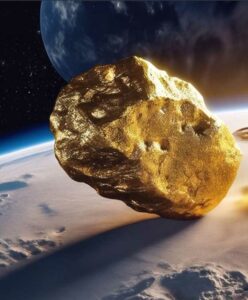 Gold has always been more than just a metal. Its rarity, resistance to time, and unique radiance have made it a measure of wealth, a guarantee of power, and a symbol of eternity. But in the 21st century, gold is being rediscovered — not only beneath the ground, but also on the horizons of space. Modern science and industry tie its destiny simultaneously to the craters of Mars, the frozen surface of the Moon, and the eternal snows of the Andes, where for thousands of years humans have extracted this metal with their own hands.
Gold has always been more than just a metal. Its rarity, resistance to time, and unique radiance have made it a measure of wealth, a guarantee of power, and a symbol of eternity. But in the 21st century, gold is being rediscovered — not only beneath the ground, but also on the horizons of space. Modern science and industry tie its destiny simultaneously to the craters of Mars, the frozen surface of the Moon, and the eternal snows of the Andes, where for thousands of years humans have extracted this metal with their own hands.
On Mars, the interest in gold is primarily geological. Studies of Martian meteorites that have fallen to Earth show the presence of gold in microscopic concentrations, confirming the similarity of planetary chemical evolution. In 2025, the Perseverance rover continued its work in Jezero Crater, where photos and spectral data revealed signs of rocks subjected to massive meteorite impacts. Scientists described these findings as a “gold vein” in the scientific sense: although the tiny traces of gold there have no industrial value, they are key to understanding the processes of crust formation on the Red Planet. This is an important step, since knowledge of Martian geology is not only of academic interest, but also preparation for future resource extraction.
The Moon, by contrast, is becoming the subject of direct strategic plans. Its surface is rich not only in helium-3 and rare earth elements, but also in metals, including gold. Reports from European and Canadian researchers openly refer to a coming “lunar gold rush,” which could begin in the coming decades. The Artemis Accords, signed by more than twenty countries including the U.S., Canada, and a number of European powers, are already in effect, aiming to secure the legal basis for future extraction. International law remains unclear: the 1967 Outer Space Treaty prohibits national appropriation of celestial bodies, but the question of commercial mining remains open. If gold is indeed found in accessible form, it will spark a new era of political and economic disputes — who will control space mining and how its benefits will be divided.
Meanwhile, gold is already serving humanity in space. In the MOXIE device, designed to produce oxygen from Mars’ atmosphere, gold is used in its construction thanks to its unique durability: it does not oxidize, conducts heat, and reflects radiation. Thin gold coatings protect instruments on orbital satellites from overheating, while gold connectors ensure stable operation of electronic systems under extreme conditions. Thus, gold becomes not an ornament, but a tool for survival — a quiet hero of scientific and technological progress.
On Earth, the golden reality is no less captivating. In the Andes of South America lie some of the world’s largest deposits. In Peru and Chile, gold is mined at altitudes above 4,000 meters, where the air is thin and the climate harsh. In 2025, dozens of industrial projects are active in the region, including the giant Yanacocha mine in Peru and new developments in Argentina’s San Juan province. Annual gold production in the Andes is measured in hundreds of tons, and the metal remains one of the continent’s most important export resources. While space mining remains hypothetical, South America today embodies the terrestrial scale of the gold economy.
The connection between earthly and cosmic gold also has a philosophical dimension. Supernova explosions and neutron star mergers created gold in the universe billions of years ago, and these elements eventually ended up in Earth’s crust, in mountain ranges like the Andes and elsewhere. When we mine the metal from the Earth’s depths, we are in fact extracting traces of ancient cosmic catastrophes. And when we dream of mining gold on the Moon or Mars, we are closing the circle — returning the metal to the universal context from which it originated.
This perspective changes the very meaning of value. Gold ceases to be only a measure of wealth and becomes part of planetary and interplanetary history. It connects different levels — personal and global, economic and philosophical, earthly and cosmic. In the 21st century, gold remains an unshakable symbol of trust, but now that trust extends beyond our planet. If on the slopes of the Andes millions of workers extract the metal, while on the Moon and Mars robots search for it and expeditions are being planned, the overall meaning is the same: gold is the material that helps humanity link past with future, memory with hope, Earth with sky.
